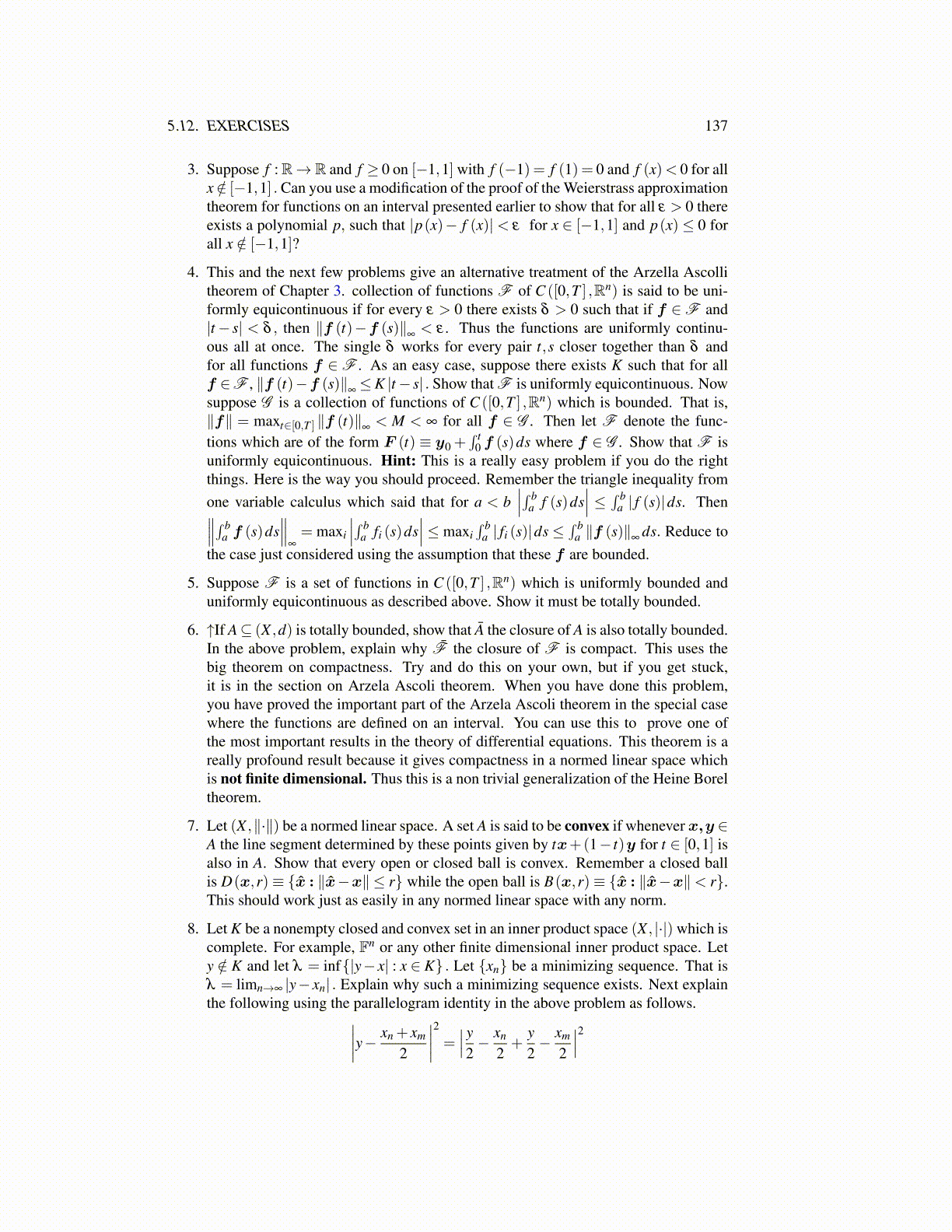
5.12. EXERCISES 137
3. Suppose f :R→ R and f ≥ 0 on [−1,1] with f (−1) = f (1) = 0 and f (x)< 0 for allx /∈ [−1,1] . Can you use a modification of the proof of the Weierstrass approximationtheorem for functions on an interval presented earlier to show that for all ε > 0 thereexists a polynomial p, such that |p(x)− f (x)| < ε for x ∈ [−1,1] and p(x) ≤ 0 forall x /∈ [−1,1]?
4. This and the next few problems give an alternative treatment of the Arzella Ascollitheorem of Chapter 3. collection of functions F of C ([0,T ] ,Rn) is said to be uni-formly equicontinuous if for every ε > 0 there exists δ > 0 such that if f ∈F and|t− s| < δ , then ∥f (t)−f (s)∥
∞< ε . Thus the functions are uniformly continu-
ous all at once. The single δ works for every pair t,s closer together than δ andfor all functions f ∈F . As an easy case, suppose there exists K such that for allf ∈F , ∥f (t)−f (s)∥
∞≤K |t− s| . Show that F is uniformly equicontinuous. Now
suppose G is a collection of functions of C ([0,T ] ,Rn) which is bounded. That is,∥f∥ = maxt∈[0,T ] ∥f (t)∥
∞< M < ∞ for all f ∈ G . Then let F denote the func-
tions which are of the form F (t) ≡ y0 +∫ t
0 f (s)ds where f ∈ G . Show that F isuniformly equicontinuous. Hint: This is a really easy problem if you do the rightthings. Here is the way you should proceed. Remember the triangle inequality fromone variable calculus which said that for a < b
∣∣∣∫ ba f (s)ds
∣∣∣ ≤ ∫ ba | f (s)|ds. Then∥∥∥∫ b
a f (s)ds∥∥∥
∞
= maxi
∣∣∣∫ ba fi (s)ds
∣∣∣ ≤ maxi∫ b
a | fi (s)|ds ≤∫ b
a ∥f (s)∥∞
ds. Reduce tothe case just considered using the assumption that these f are bounded.
5. Suppose F is a set of functions in C ([0,T ] ,Rn) which is uniformly bounded anduniformly equicontinuous as described above. Show it must be totally bounded.
6. ↑If A⊆ (X ,d) is totally bounded, show that Ā the closure of A is also totally bounded.In the above problem, explain why F̄ the closure of F is compact. This uses thebig theorem on compactness. Try and do this on your own, but if you get stuck,it is in the section on Arzela Ascoli theorem. When you have done this problem,you have proved the important part of the Arzela Ascoli theorem in the special casewhere the functions are defined on an interval. You can use this to prove one ofthe most important results in the theory of differential equations. This theorem is areally profound result because it gives compactness in a normed linear space whichis not finite dimensional. Thus this is a non trivial generalization of the Heine Boreltheorem.
7. Let (X ,∥·∥) be a normed linear space. A set A is said to be convex if whenever x,y ∈A the line segment determined by these points given by tx+(1− t)y for t ∈ [0,1] isalso in A. Show that every open or closed ball is convex. Remember a closed ballis D(x,r)≡ {x̂ : ∥x̂−x∥ ≤ r} while the open ball is B(x,r)≡ {x̂ : ∥x̂−x∥< r}.This should work just as easily in any normed linear space with any norm.
8. Let K be a nonempty closed and convex set in an inner product space (X , |·|) which iscomplete. For example, Fn or any other finite dimensional inner product space. Lety /∈ K and let λ = inf{|y− x| : x ∈ K} . Let {xn} be a minimizing sequence. That isλ = limn→∞ |y− xn| . Explain why such a minimizing sequence exists. Next explainthe following using the parallelogram identity in the above problem as follows.∣∣∣∣y− xn + xm
2
∣∣∣∣2 = ∣∣∣ y2 − xn
2+
y2− xm
2
∣∣∣2